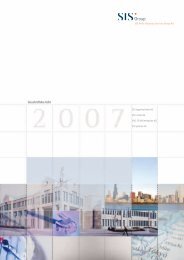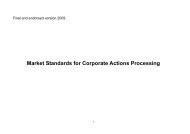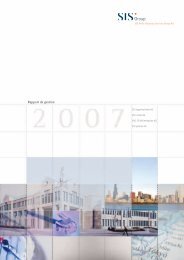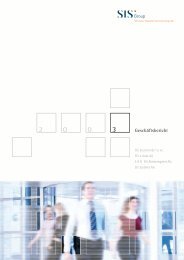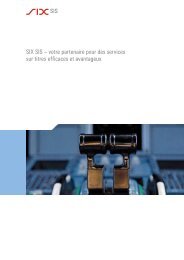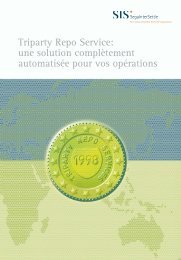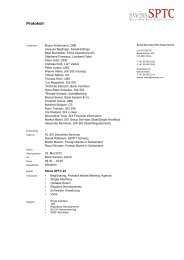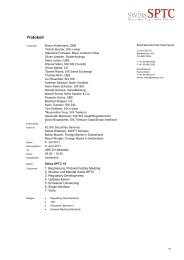Elimination of Giovannini Barrier One Final Protocol recommendation
Elimination of Giovannini Barrier One Final Protocol recommendation
Elimination of Giovannini Barrier One Final Protocol recommendation
Create successful ePaper yourself
Turn your PDF publications into a flip-book with our unique Google optimized e-Paper software.
<strong>Giovannini</strong> <strong>Barrier</strong> <strong>One</strong> – <strong>Final</strong> <strong>Protocol</strong> <strong>recommendation</strong><br />
7.7 Others<br />
Unqualified support for the <strong>Protocol</strong> as a solution to <strong>Barrier</strong> <strong>One</strong> has been <strong>of</strong>fered by the following EU and<br />
non-EU organisations, although in many cases, concerns were expressed in relation to the originally<br />
identified timeframes:<br />
Hong Kong Monetary Authority<br />
Hong Kong Exchange<br />
ISITC US<br />
Japanese National Market Practice Group/ISITC Japan<br />
Jasdec<br />
SIS SegaIntersettle<br />
SIS x-clear<br />
South African National Market Practice Group<br />
Swiss Commission for Financial Standardisation (SCFS)<br />
Thailand Securities Depository<br />
In addition to concerns about implementation timeframes, further qualified support for the solution,<br />
summarised below, was provided by the following organisations:<br />
BT Radianz: Considers this “an appropriate solution to the elimination <strong>of</strong> <strong>Barrier</strong> <strong>One</strong> for equities and<br />
fixed income clearing and settlement”, that the industry should use “the most widely adopted standard for<br />
clearing and settlement in each individual asset class” and that a “high level <strong>of</strong> interoperability between<br />
standards within one agreed protocol should be the industry's goal”. BT Radianz “supports the use <strong>of</strong><br />
open, industry-driven and industry-owned standards and believes participants should be free to use those<br />
most appropriate to their needs and, as such, standards should not be mandated by other parties”.<br />
FIX <strong>Protocol</strong> Ltd: Answered “yes provided that the scope is settlement processing and that the distinction<br />
between ISO 15022 and ISO 20022 and the depiction <strong>of</strong> standards within diagram 1 is clarified”. FPL also<br />
believes that “extending the most widely adopted standard in a space to universal coverage is the best<br />
first step towards achieving the industry's goals <strong>of</strong> simplicity, automation and ROI”. Thus, for the focus on<br />
cash equities and fixed income, FPL sees “the FIX <strong>Protocol</strong> being used from pre-trade up to and including<br />
post-trade and pre-settlement, and the ISO 15022 messages to service settlement”.<br />
SIA: Whilst being generally supportive <strong>of</strong> the initiative in a European context, SIA caution that it is “difficult<br />
to predict how relevant this cross-border protocol would be for and among more autonomous markets<br />
outside <strong>of</strong> the EU, if its expansion were proposed at any stage”.<br />
It should be noted that STRATE, the South African CSD, felt the <strong>Protocol</strong> was an inappropriate solution to<br />
<strong>Barrier</strong> <strong>One</strong> due to the <strong>recommendation</strong> <strong>of</strong> both ISO 15022 and ISO 20022, as well as expressing<br />
reservations about the timelines.<br />
Gio_<strong>Barrier</strong>1_<strong>Protocol</strong>Recom_v2.doc Page 19



